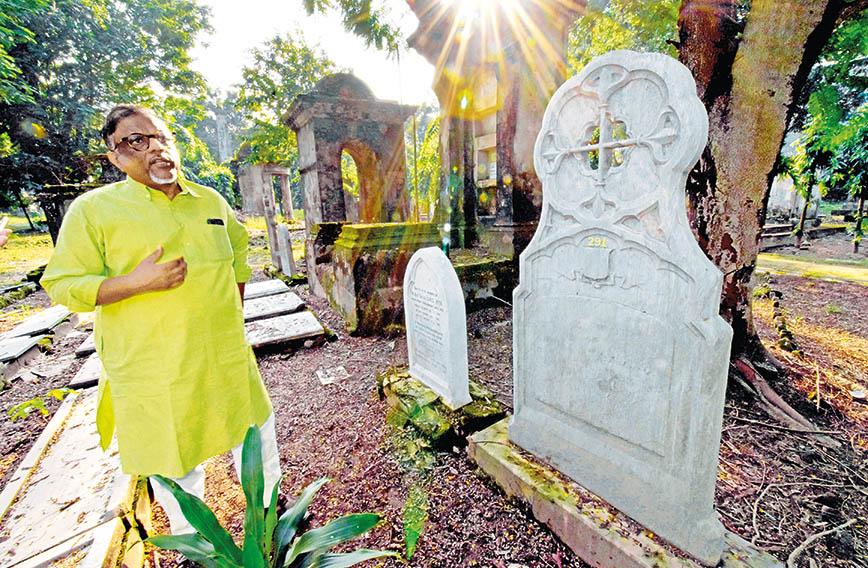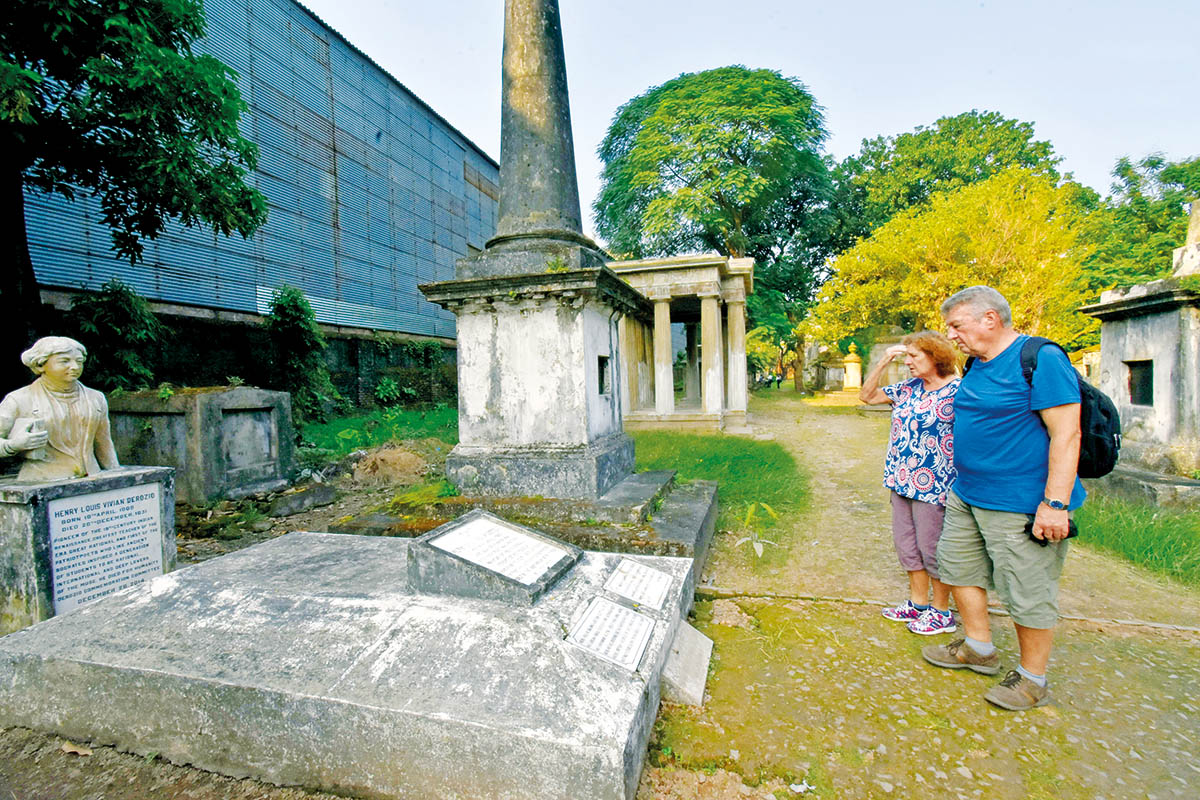
Mudar Patherya at the South Park Street Cemetery, which has graves dating back to the early years of the East India Company
Facelift for a historic cemetery
Aiema Tauheed, Kolkata
CITIES don’t know to stand still. So where should one discover their past? Graveyards are a good place to go, ask Mudar Patherya, Kolkata’s very own heritage activist.
Patherya has been restoring tombstones in the South Park Street Cemetery where a chunk of Kolkata’s history, dating back to 1767, can be found on its eight acres.
Here lie buried many of the names associated with the East India Company and the cultural past of the city. There is William Jones, founder of the Asiatic Society, Walter Dickens, son of Charles Dickens, Henry Louis Vivian Derozio, poet and radical social reformer, Charles Stuart, famed for his treatise on Hinduism, judges, officials, soldiers and ordinary people of the East India Company.
For 1,600 British men, women and children this cemetery, with its elegantly crumbling tombs, cenotaphs and mausoleums, was their last resting ground.
Patherya finds the South Park Street Cemetery fascinating because it was founded ages ago, in 1767, just 125 years after the Taj Mahal was built, but survives till today. The tombstones tell their own stories. The British amassed wealth but life was short for some, as the epitaphs reveal. However, they wanted to ensure their memory lived on, hence the grand and extensive masonry over their graves.
The British had no culture of such tombstones, says Patherya. While some are built in a jumble of European styles, the influence of Indian architecture, like the Taj Mahal, is evident, specifically in the graves near the entrance.
“It all started with one plaque,” he says, making his way to a tombstone inscribed in three languages: Bengali, English, and, notably, Urdu. As the administrator of an Urdu group, Patherya noticed the Urdu inscription and suggested they restore it. This tombstone, Number 1331, belonged to Samuel Smith, a British politician.
Patherya figured if he restored, say, 500 of the 1,600 tombstones, it wouldn’t cost too much. Confident he could raise the funds, he decided to move forward. He launched his project on August 26 and by October 26 last year, the first phase of his project was successfully concluded with an impressive 1,300 tombstones gleaming anew.
Patherya first approached the Christian Burial Board with a request for permission to clean all the plaques that needed restoration. He submitted a proposal, which was subsequently accepted.
From this point on he started raising funds. He tasked Khurshid Alam, who has been working closely on this project, with locating the tombstones for repair.
“Charles Dickens’ son’s tombstone is somewhere on the premises,” says Patherya with a frown, his eyes squinting as he scans the graves. “I’ll have to find exactly where. It was brought all the way from the Bhowanipore Cemetery.”
Then, pointing at a temple-like structure with a dome on top, he says, “And then there’s Charles ‘Hindoo’ Stuart’s tomb with a temple on top. There’s a market in North Calcutta called Tiretta Market. Tiretta’s wife’s tombstone is here as well.”
He leads the way to the grave of Henry Louis Vivian Derozio, poet, social reformer and assistant headmaster of Hindu College, Calcutta, who died of cholera at the age of 22. Patherya says he did not need to do much for Derozio’s grave as it was in relatively good condition. He explains that Derozio’s grave is visited by students during the winter months and they leave it covered with roses. A few dried roses lay scattered.
For financing this project, he turned to crowdfunding. He reached out to peoplehe knew, asking for contributions of `10,000 each. The total budget he had drawn up came to `9,29,000.
“If you crowdfund small amounts from a large number of people, it works,” he says. “Many of my contributors are supporting a heritage project for the first time. All donors remain happily anonymous.”
He has been working to build a community of donors and got the support of 171 private donors. The tombstone cleaning project drew contributions from 99 of these donors.
“Actually, it’s not a large amount. If I’m raising 10,000 rupees each, I only need 92 people. In a city of 15 million, 92 is nothing. This was achieved without any real public launch, just private outreach to people who know me. So, I think a fair amount has been raised privately,” he says. His reporting mechanism has also helped. All donations were collected via cheque, directed into his foundation, which also pays solely by cheque. They also keep reporting back to their donors periodically.
He encountered some challenges with the rain, but praised the dedication of his team. “They worked virtually every waking hour, right from eight o’clock in the morning to about five o’clock in the evening, I think for every single day for two months, and they’ve completed 1,300 tombstones,” Patherya says proudly.
 People come from all over to identify graves and tombstones
People come from all over to identify graves and tombstones
Some tombstones haven’t been restored by him as they were in relatively good condition. “With six to seven people, we’ve managed to clean around 30 tombstones each day,” says Khurshid, manager of the project.
Patherya notes how this project has brought attention to the heritage value of the South Park Street Cemetery, which hadn’t been in the news for decades before this. “Some people have even come forward and offered additional money and support. They would never have done that before.”
The Christian Burial Board too has been very forthcoming, quick and professional, he says. Margaret Ekka, manager and secretary of the board, confirmed that 1,300 tombstones have been restored. Some are still cracked and broken with illegible inscriptions.
People have begun to appreciate the significance of the place. Earlier, most people would pass by Park Street without realizing such a historical site exists.
He now has plans to illuminate parts of the cemetery, should he receive permission. Additionally, he envisions opening it up for visitors in the evening, after five or six o’clock, on select days of the week, to help bring more attention to the site and move the project forward.
“So, you know, we are not saying that our work is over. We’re trying to ask them if there’s anything else we can do. Can we help restore or rehabilitate some of these structures?” says Patherya.
Many of the tombstones lie broken and scattered across the cemetery, with leaves covering them. Would he be keen to maintain the site? Patherya responds, “Yes, you see, a lot of leaves fall, and it is not being taken care of. I think once a year, I’ll have to do something.”
He points to a few broken pieces of tombstones scattered on the pathway and says he’d like to create a cemented area to properly place the broken stones back, positioning them with a slight slant. Cleaning up the trash in the cemetery is the next step.
“The entire project will cost less than `10 lakh,” he reflects. “Why wasn’t the world doing it? The big fear is that it will cost a lot of money. In fact, we could have shrunk this to about `7 lakh. Now that I’ve understood the terrain, I’m ready to adopt more cemeteries if required.”
“From this cemetery, we are going to move to the next cemetery,” he says. He has his eye on the Lower Circular Road Cemetery, where the graves of C.F. Andrews, educator, social reformer and a proponent of India’s struggle for freedom, Michael Madhusudan Dutt, epic poet and playwright, and many others are located.
As we walked through the cemetery, dragonflies flitted through the greenery. Gentle sunlight fell on the tombstones, casting a soft glow. Patherya often paused at the tombstones along the way. “That’s beautiful,” he would murmur, snapping photos of the cleaned stones on his phone.
With bright-eyed passion, he says, “I think Kolkata is one of the most romantic cities in the country. Whatever you do can have a very decisive and dramatic shift in tourism and conservation.” It is a city in which it is easy to find a purpose to life.
Comments
Currently there are no Comments. Be first to write a comment!





